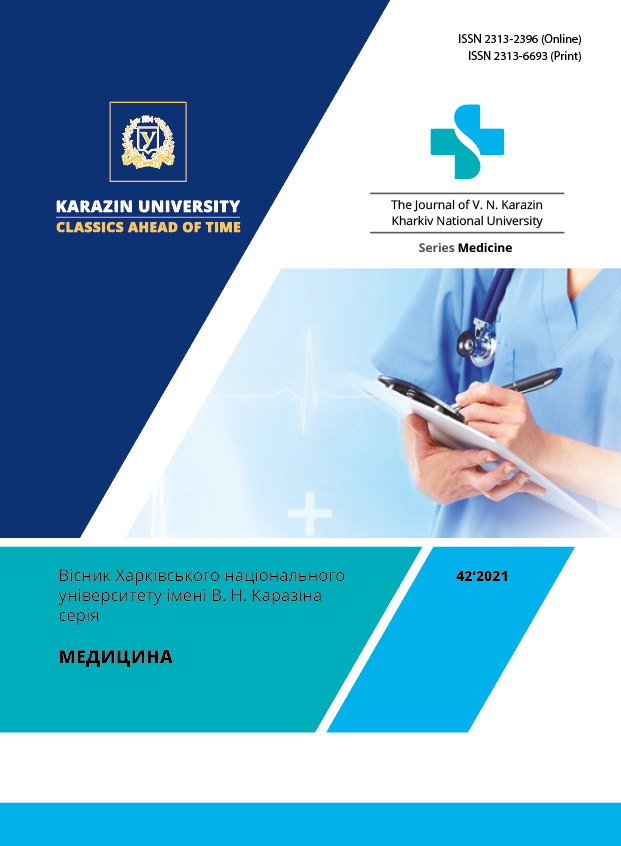Нечітка логіка в диагностиці варіабельності серцевого ритму
Анотація
Вступ. Варіабельність серцевого ритму (ВСР) базується на вимірюванні (часу) інтервалів між R-піками (RR-інтервалів) електрокардіограми (ЕКГ) з поданням їх у вигляді ритмограми і подальшого аналізу різними математичними, які класифікуються як методи (метрики) тимчасової області, частотної області і нелінійні. Різноманітність методів і підходів до аналізу ВСР обумовлено комплексністю і нелінійністю самого явища, а також великою різноманітністю фізіологічних реакцій організму, як в нормі, так і при патологічних станах. Тому, видається актуальним і важливим інкорпорування наявних на сьогоднішній день показників і норм ВСР в єдину методику, що дозволяє інтегрально оцінити кожну з метрик і результати ВСР в цілому. Мета. У статті запропоновано алгоритм нечіткої логіки (FL) для включення в єдине уявлення кожної з метрик – тимчасової області (TD), частотної області (FD), нелінійних методів (NM) і ВСР в цілому. Матеріали та методи. Ми визначаємо за допомогою FL ступінь приналежності до нормального стану як для кожного окремого показника ВСР – TD, FD і NM, так і для ВСР пацієнта в цілому. Визначено функції приналежності до будь-якого індексу ВСР і правила дефуззіфікації для оцінок FL. Для реалізації запропонованого алгоритму в наукових публікаціях по ВСР знайдені задані параметри середніх значень показників ВСР (М) і їх стандартного відхилення (σ) [1, 3, 7, 8, 9, 10]. Демонстрація роботи запропонованого алгоритму виконувалася на підставі 24-годинних записів ВСР з бази даних MIT-BIH [11] для пацієнтів з нормальним синусовим ритмом (NSR), серцевою недостатністю (CHF) і фібриляції передсердь (AF) [12]. Результати і висновки. Цілісний погляд на ВСР можливий тільки тоді, коли є технологія, подібна нечіткої логіки, що дозволяє об'єднати всі використовувані методи і підходи в інтегральну оцінку. Ми представили подібну FL технологію в цій статті і докладно розглянули особливості її застосування та інтерпретації. З усіх розглянутих прикладів FL аналізу найгірший результат демонструє пацієнт з групи AF, а найкращий з групи NSR. Відмінність в FL оцінках у даних пацієнтів з груп NSR і CHF становить майже 4 рази, а у NSR і АF – майже 6 раз. Особливо важливим є імплементація подібної розробки в носяться медичних пристроях для швидкої і легкої інтерпретації численних параметрів, які вони вимірюють.
Завантаження
Посилання
Task force of the European society of cardiology and the North American society of pacing and electrophysiology. Heart rate variability – standards of measurement, physiological interpretation, and clinical use. (1996). Circulation, 1996. vol. 93, iss. 5, pp.1043–1065.
Yabluchansky N., Martynenko A. (2010). Heart Rate Variability for clinical practice. 2010. Kharkiv, Univer. Press, 131 p. (in Russ.) depositary: http://dspace.univer.kharkov.ua/handle/ 123456789/1462
Voss A, Schroeder R, Heitmann A, Peters A, Perz S. (2015) Short-Term Heart Rate Variability—Influence of Gender and Age in Healthy Subjects. PLoS ONE. 2015; 10 (3): e0118308
Shafler F., Ginsberg J.P. (2017). An Overview of Heart Rate variability Metrics and Norms // Frontiers in Public Health, v. 5, art. 258, p.1–17. https://doi.org/10.3389/fpubh.2017.00258
Dogan I. An Overview of Soft Computing. Procedia Computer Science. 12th International Conference on Application of Fuzzy Systems and Soft Computing, ICAFS 2016, Vienna, Austria. 102: 34–38 https://doi.org/10.1016/j.procs.2016.09.366
Yanase J., Triantaphyllou E. (2019). A Systematic Survey of Computer-Aided Diagnosis in Medicine: Past and Present Developments // Expert Systems with Applications. 138:112821. https://doi.org/10.1016/j.eswa.2019.112821
Martynenko A, Raimondi G, Budreiko N. Time Irreversibility and Complexity of Heart Rate Variability. Journal of V. N. Karazin` KhNU Series «Medicine». 2021; 41: 5–15. https://doi.org/10.26565/2313-6693-2021-41-01
Nunan D., Sandercock G., Brodie D. (2010). A quantitative systematic review of normal values for short-term heart rate variability in healthy adults. Pacing Clin Electrophysiol. 2010; 33: 1407–1417.
Umetani K, Singer DH, McCraty R, Atkinson M. (1998). Twenty-four hour time domain heart rate variability and heart rate: relations to age and gender over nine decades. J Am Coll Cardiol. 1998
Nastanova z kardiologii (2009). Red. Kovalenko V.M., Кyiv, МОРІОН, 2009,1368 p. [in Ukrainian]
Goldberger, A.L. et al. (2000). Physiobank, physiotoolkit, and physionet: Components of a new research resource for complex physiologic signals. Circulation, 2000, 101, 215–220.
Moody GB, Mark RG. (1983). A new method for detecting atrial fibrillation using R-R intervals. Computers in Cardiology, 1983, 10: 227–230.
Вісник Харківського національного університету імені В. Н. Каразіна, серія Медицина має такі умови авторського права:
1. Автори зберігають авторські права та надають журналу право на першу публікацію разом із роботою, яка одночасно ліцензується згідно з ліцензією Creative Commons Attribution License, яка дозволяє іншим ділитися роботою з визнанням авторства роботи та першої публікації в цьому журналі.
2. Автори можуть укладати окремі додаткові договірні угоди щодо неексклюзивного розповсюдження опублікованої журналом версії роботи з підтвердженням її початкової публікації в цьому журналі.
3. Авторам дозволяється та заохочується публікувати свої роботи в Інтернеті до та під час процесу подання, оскільки це може призвести до продуктивного обміну, а також до раннього та більшого цитування опублікованої роботи.




